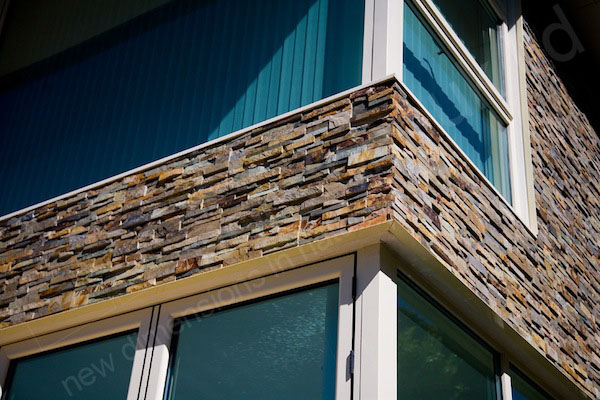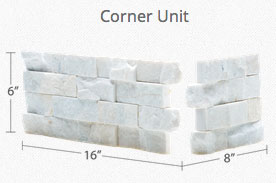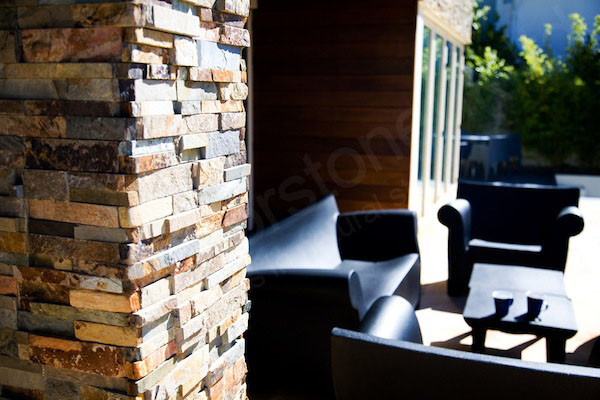Norstone Classroom Series - Working With Corners
 There comes a point in most stone veneer projects where the stone will need to go around an outside corner to either continue along, or terminate into another wall or structure. Outside corners occur anywhere two wall sections intersect and form an external angle, such as the outside corner of a home. Norstone’s Outside Corner Unit, available in both the Rock Panel and XL Rock Panel Series, is the thin veneer industry’s most advanced corner system.
There comes a point in most stone veneer projects where the stone will need to go around an outside corner to either continue along, or terminate into another wall or structure. Outside corners occur anywhere two wall sections intersect and form an external angle, such as the outside corner of a home. Norstone’s Outside Corner Unit, available in both the Rock Panel and XL Rock Panel Series, is the thin veneer industry’s most advanced corner system.
 There is no other manufacturer that uses multiple fingers per unit to create a seamless, interlocking unit that allows for consistent stone texture and cleft all the way around the corner. Each corner unit is comprised of two pieces, each at 6” tall, with one measuring approximately 8” and the other approximately 16”, covering about one square foot of wall space.
There is no other manufacturer that uses multiple fingers per unit to create a seamless, interlocking unit that allows for consistent stone texture and cleft all the way around the corner. Each corner unit is comprised of two pieces, each at 6” tall, with one measuring approximately 8” and the other approximately 16”, covering about one square foot of wall space.
Calculating the right mix of field and corner units for your project is a critical step to staying on time and in budget. Here are some easy to follow steps to determine how much material should be ordered which can be applied to any project with outside corners.
.jpg)
Step 1 - Determine how many lineal feet of outside corner for your project. In the example fireplace to the left, we have a project with two outside corners, each 8’, for a total of 16 lineal feet.
Step 2 - Multiply your lineal feet x 2 to get the number of corner units. Each corner unit is 6” tall, so by multiplying your lineal footage by 2, you calculate the total number of corner units you need. In our example, we have 16 lineal feet of outside corner, so we’ll need 32 corner units.
Step 3 - Calculate the Total square footage of your project. For help on measuring and calculating square footage, visit our earlier blog post on this topic. In our example, the front facing walls of the fireplace total 48 sq ft and each side is 15.67 sq ft, for a total of 79.34 sq ft for the front and both sides. The firebox, where stone will not be needed, totals 10 sq ft, so the total sq ft for the project is 69.34 sq ft.
Step 4 - Deduct the Corner Units from your Total Square Footage. Since each corner unit is going to cover about one square foot of wall space with its 8” and 16” returns, you should deduct the appropriate amount of field units from the total sq ft of the project. In this example, the project requires 32 corner units and the total sq ft on the job is 69.34 sq ft. Deducting the corner units from the total square footage leaves us with 37.34 sq ft of field units and 32 sq ft of corner units.
Step 5 - Add in Waste and Round to the nearest box count. We recommend adding 10% to your total material requirement which is a standard overage factor for tile and stone installations and covers miscellaneous items like cuts, waste, and breakage in transit / on site. Round your final numbers up to the nearest box count (4 sq ft per box) for the final material requirement for your project. In our example, we’d end up recommending 44 sq ft of field units and 36 sq ft of corner units.
 Not all projects are as basic as the example presented above. Particularly tricky corner calculations come up when you are working on projects that have a short return, which is the distance between the outside corner and end point, and columns. Any of the friendly Norstone reps can help with even the most complex corner unit calculation, and are a good resource to double check your calculations if you’ve done your own. Just give us a call or fill out our contact form and someone will call you back. Nobody knows these corner units better than us, so let us help you calculate your project’s material requirements and stay on time and in budget!
Not all projects are as basic as the example presented above. Particularly tricky corner calculations come up when you are working on projects that have a short return, which is the distance between the outside corner and end point, and columns. Any of the friendly Norstone reps can help with even the most complex corner unit calculation, and are a good resource to double check your calculations if you’ve done your own. Just give us a call or fill out our contact form and someone will call you back. Nobody knows these corner units better than us, so let us help you calculate your project’s material requirements and stay on time and in budget!
.png)




.jpg)